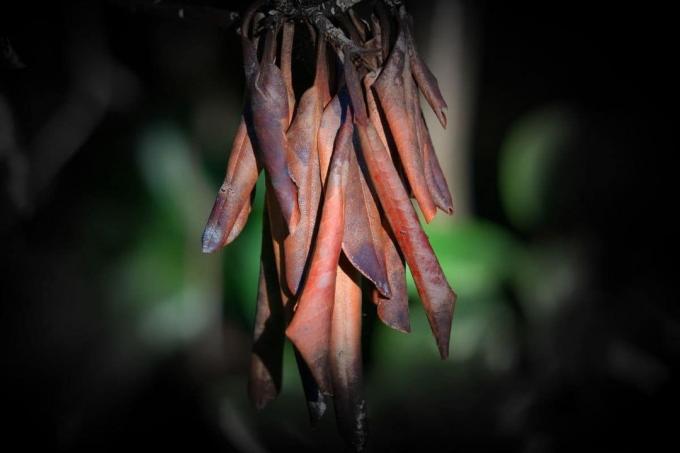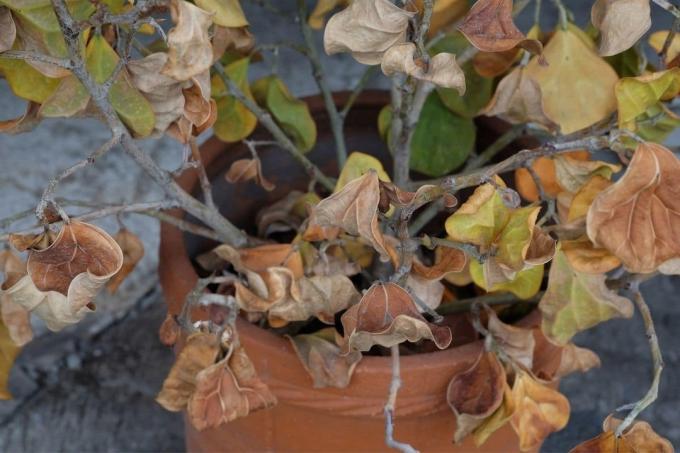
table of contents
- Endangered Plants
- What is happening?
- Symptoms that occur
- Preventive measures
- frequently asked Questions
The garden is quiet in winter, but with its low temperatures it can cause tremendous damage. Plants, trees and bushes suffer from this, and the phenomenon of frost drought is particularly treacherous.
In a nutshell
- also known as the winter drought
- Plants literally die of thirst
- evergreen plants particularly endangered
- The leaves and needle are discolored
Endangered Plants
The phenomenon of frost drought consists in the fact that the plants do not simply freeze to death over winter, but rather die of thirst. This frost damage is also known as winter drought. It is certainly a little difficult to understand that garden plants dry up, especially in winter. It does not affect all plants either, because only evergreen shrubs, trees and other plants are particularly at risk
- Yew tree (Taxus baccata)
- Tree of Life (Thuja)
- Juniper (Juniperus)
- False cypress (Chamaecyparis)
- Cedar (Cedrus)
- Pine
- Fir (Abies)
- Spruce (Picea)
- Rhododendron (rhododendron)
- evergreen species of snowball (vibirnum)
- Loquat (Photinia)
- Loquat (Cotoneaster)
- Barberry (Berberis)
- Spindle bush (Euconymus)
- Ivy (Hedera helix)
- Cherry laurel (Prunus laurocerasus)
- Boxwood (Buxus sempervirens)
- Holly (Ilex)
- hardy palm trees (Arecaceae)
- Elven flowers (Epimedium)

Note: Some plants have already developed various protective mechanisms here. For example, the rhododendron and also the cherry laurel leaves its leaves to reduce evaporation.
What is happening?
The leaves of the evergreen plants transpire even when the temperature is below zero during the cold season. A lot of water is lost in the process. This moisture would normally then have to be absorbed from the soil again via the roots. However, problems can arise here, because at very low soil temperatures, i.e. minus degrees, the water there is bound as ice crystals. But not only the soil and the water are frozen, but also the plant roots. They are then no longer able to absorb and transport water and nutrients in order to compensate for the loss of perspiration by the leaves. It gets particularly bad when the first rays of sun come out in late winter, which increases the water evaporation from the leaves enormously. Normally, there are two different types of frost-dryness.

Complete cessation of water supply
- rapid opening of the stomata (stomata) on the underside of the epidermis
- Openings are used for gas exchange
- thereby increased transpiration of water
- Replenishment from the ground not possible
- so no supply of the plant parts with water
Training of chronic damage
- Stomata remain closed
- Water release through the cuticle (waxy layer over shoots and leaves)
- endangered plants conifers and deciduous trees

The consequences of frost drought can be particularly bad for phanerophytes, especially when there is a clear frost or frost. when the plants are in places with little snow. These are plants with woody, aboveground plant parts that overwinter in renewal buds.
Symptoms that occur
The symptoms of frost drought are little different from symptoms that occur when a plant suffers from a lack of water:
- brown spots on leaves
- leaves drooping at first
- later withered leaves
- stick to tree / shrub
- brown needles in conifers
- brown colored shoots
- partial death of the shoots

The complete damage to the plant does not show up until spring. Affected plants do not always die. Quick help here can be watering and a strong pruning should also be made. This can stimulate a new shoot. However, a little patience is required. Because it may be that the first new shoots only appear late in June or July. However, if the plant shows no change after months and looks completely brown and dry, only clearing and disposal of the plants will help.
Preventive measures
In order to protect particularly endangered crops from a winter drought, sufficient watering throughout the year can help. There are also various measures that contribute to protection:
- Water evergreen plants on frost-free days
- The ground must not be frozen
- otherwise no water absorption possible
- don't pour too much right away
- rather more regularly if the weather permits
- Avoid waterlogging
- Pay particular attention to potted plants
- Otherwise, the expanding water can shatter the planter
- Always check the earth's surface for moisture first
- Spreading a layer of mulch made from compost, leaves or chaff
- additionally cover the root disc generously with:
- Brushwood, jute sacks, light synthetic fleece, sheep fleece, willow, - thatched or reed mats
- Do not use dark fleece, as it reflects the sun

Alternatively, potted plants or sensitive evergreen shrubs and trees can be completely wrapped in a light fleece or jute sack. In this way they are protected from the rays of the winter sun and the transpiration of the leaves is restricted.
Note: It can also be helpful to give plenty of water in autumn to October / November. The soil should be well moistened. 30 to 40 liters of water per square meter are appropriate.
frequently asked Questions
There is already talk of a frosty day when the air temperature drops below 0 ° C for some time at a height of two meters. Even at air temperatures around 2 to 4 ° C there can be frost (ground frost) directly on the ground, i.e. the temperatures here are below freezing point. The reason for this is that the heavy air sinks to the floor from top to bottom. In general, all water freezes in frost.
Yes, absolutely. The plants show similar symptoms for both frost damage. If a plant freezes to death, all of its cells are destroyed by ice crystals. Affected plants can then no longer carry out the metabolism. As a result, wilted and brown leaves appear, just like with frost-dryness. However, they get slightly muddy.
As a rule, the above-ground parts of the plant die off in most of the flowering plants in late autumn. Usually they are then cut off a hand's breadth above the ground. Such perennials are considered deciduous and do not suffer from a winter drought. The situation is different with evergreen perennials such as the elven flower or biennial flowers such as gold lacquer, horned violets or pansies. Protection against the winter drought should take place here.


